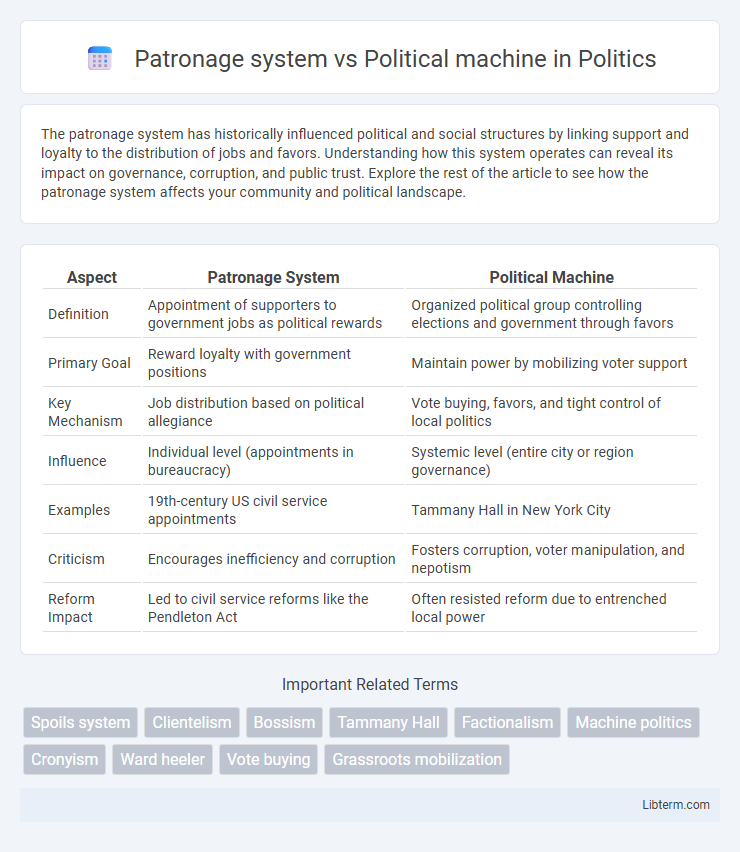The patronage system has historically influenced political and social structures by linking support and loyalty to the distribution of jobs and favors. Understanding how this system operates can reveal its impact on governance, corruption, and public trust. Explore the rest of the article to see how the patronage system affects your community and political landscape.
Table of Comparison
| Aspect | Patronage System | Political Machine |
|---|---|---|
| Definition | Appointment of supporters to government jobs as political rewards | Organized political group controlling elections and government through favors |
| Primary Goal | Reward loyalty with government positions | Maintain power by mobilizing voter support |
| Key Mechanism | Job distribution based on political allegiance | Vote buying, favors, and tight control of local politics |
| Influence | Individual level (appointments in bureaucracy) | Systemic level (entire city or region governance) |
| Examples | 19th-century US civil service appointments | Tammany Hall in New York City |
| Criticism | Encourages inefficiency and corruption | Fosters corruption, voter manipulation, and nepotism |
| Reform Impact | Led to civil service reforms like the Pendleton Act | Often resisted reform due to entrenched local power |
Introduction to Patronage Systems and Political Machines
Patronage systems distribute government jobs and favors based on political loyalty rather than merit, often fostering corruption and inefficiency. Political machines function as organized groups that control local politics through patronage, delivering votes in exchange for services and benefits. Both systems heavily influence political behavior by creating networks of dependency and reinforcing power structures within urban environments.
Historical Origins and Development
The patronage system emerged in the 19th century as a means for political leaders to reward supporters with government jobs, solidifying loyalty through direct appointments. Political machines developed as organized groups controlling votes and political power in urban areas, particularly during the late 19th and early 20th centuries, using patronage as a key tool for maintaining influence. Both systems originated from the need to mobilize and control voter bases amid rapid urbanization and immigrant population growth.
Core Characteristics of Patronage Systems
Patronage systems revolve around the exchange of jobs and favors for political support, where loyalty is rewarded through government appointments or contracts. These systems often lack transparency and promote nepotism, with positions allocated based on personal relationships rather than merit. Political machines, while also relying on patronage, integrate a structured organization that controls voter turnout and election outcomes through a hierarchical network of loyal operatives.
Defining Features of Political Machines
Political machines are organized groups that maintain power by controlling votes and rewarding loyal supporters with jobs or services, emphasizing centralized leadership and hierarchical structures. Unlike patronage systems, which broadly distribute favors based on loyalty, political machines operate through well-oiled networks that manipulate election outcomes and city governance systematically. Key features include tight party discipline, mobilization of immigrant and lower-class voters, and a focus on maintaining long-term political dominance.
Key Differences Between Patronage Systems and Political Machines
Patronage systems primarily involve the distribution of jobs and favors in exchange for political support, fostering loyalty through personal relationships. Political machines, on the other hand, are organized political groups that maintain control over a city or region by using networks of patronage but also rely heavily on mobilizing voters and controlling electoral outcomes. Key differences include the scale and organization: patronage systems are broader and less formal, whereas political machines operate as highly structured entities with hierarchical leadership focused on sustained political dominance.
Impact on Governance and Public Administration
The patronage system often leads to inefficiency in governance by prioritizing loyalty over competence, resulting in the appointment of unqualified individuals to public offices. Political machines, leveraging patronage, can consolidate power and maintain control over urban politics through vote-buying and favoritism, which undermines transparency and accountability in public administration. These practices diminish the effectiveness of government institutions and erode public trust in political processes.
Influence on Elections and Voter Behavior
Patronage systems shape electoral outcomes by exchanging jobs and favors for political support, thus reinforcing loyalty and securing votes through direct material benefits. Political machines amplify this influence by employing organized networks that mobilize voters, manipulate ballot access, and control local party structures to ensure election victories. Both systems significantly impact voter behavior by prioritizing personal allegiance over policy preferences, often limiting democratic choice and fostering dependency on political elites.
Corruption and Accountability Issues
The patronage system often fuels corruption by distributing jobs and favors based on loyalty rather than merit, undermining accountability within public institutions. Political machines exacerbate these issues by consolidating power through vote-buying, kickbacks, and manipulation of city contracts, leading to widespread abuse of authority. Both systems erode transparency and public trust, making reform and oversight challenging in maintaining ethical governance.
Reforms and Decline of Patronage and Political Machines
The patronage system, based on rewarding political supporters with government jobs, faced major reforms such as the Pendleton Civil Service Act of 1883, which introduced merit-based hiring to reduce corruption and inefficiency. Political machines, reliant on patronage and often linked to urban party bosses like New York's Tammany Hall, experienced decline due to federal investigations, progressive reforms, and changes in voter demographics. These reforms collectively weakened the grip of both patronage and political machines by promoting transparency, accountability, and professionalized public service.
Contemporary Examples and Lessons Learned
The Patronage system, exemplified by India's BJP leveraging local leadership networks for electoral support, contrasts with the political machine tactics seen in Chicago's Democratic Party, where structured party loyalty ensures voter turnout. Contemporary examples reveal that while patronage fosters personal loyalty through resource distribution, political machines rely on organizational discipline and influence over local institutions. Lessons learned emphasize transparency and accountability measures to prevent corruption and promote democratic participation within both systems.
Patronage system Infographic

 libterm.com
libterm.com